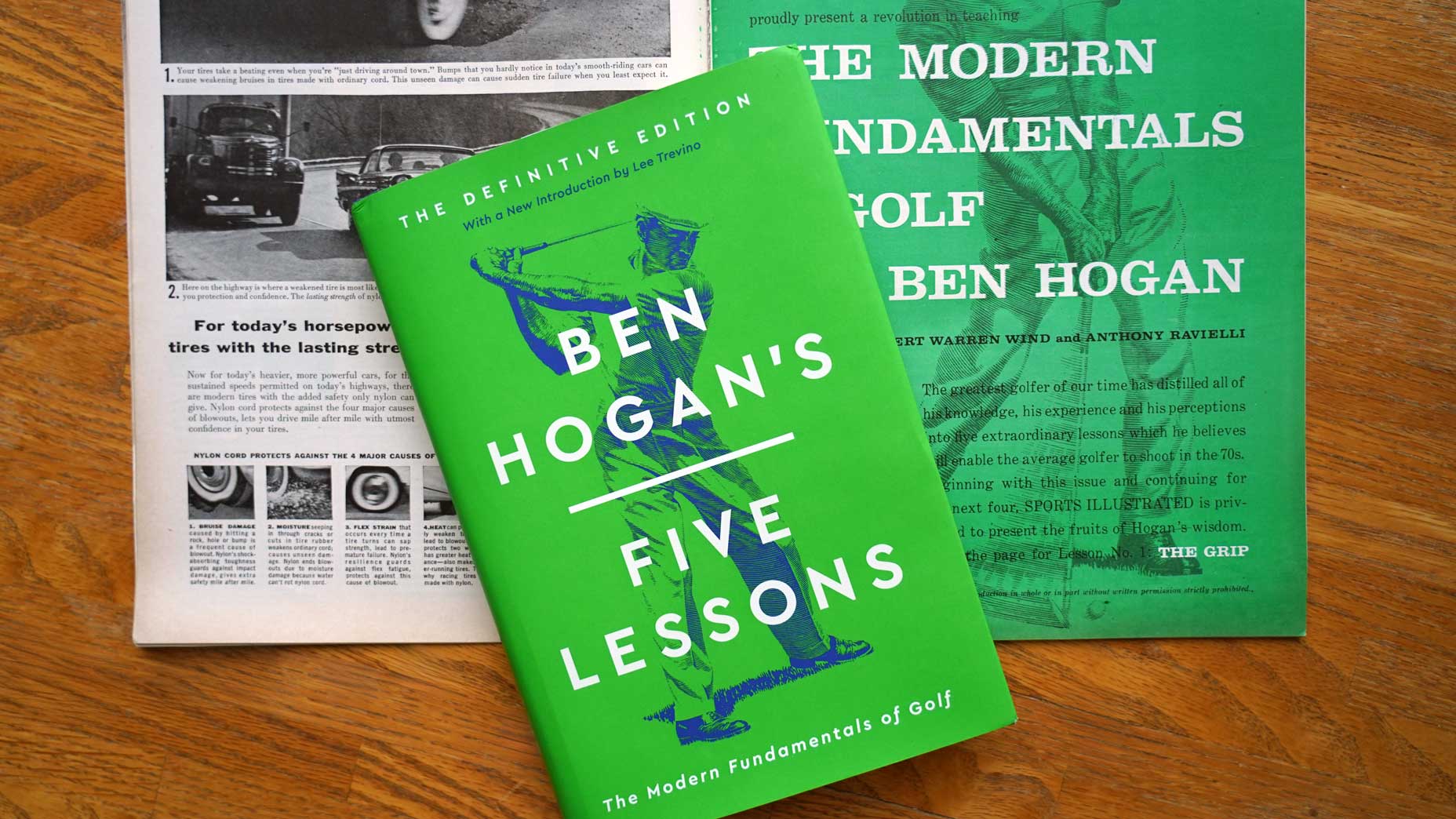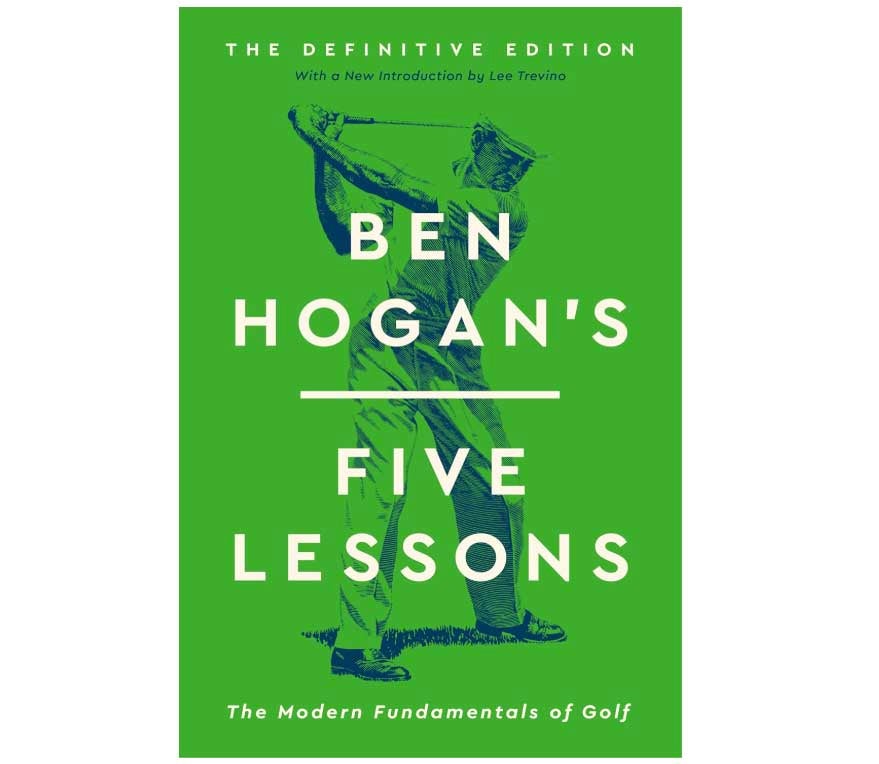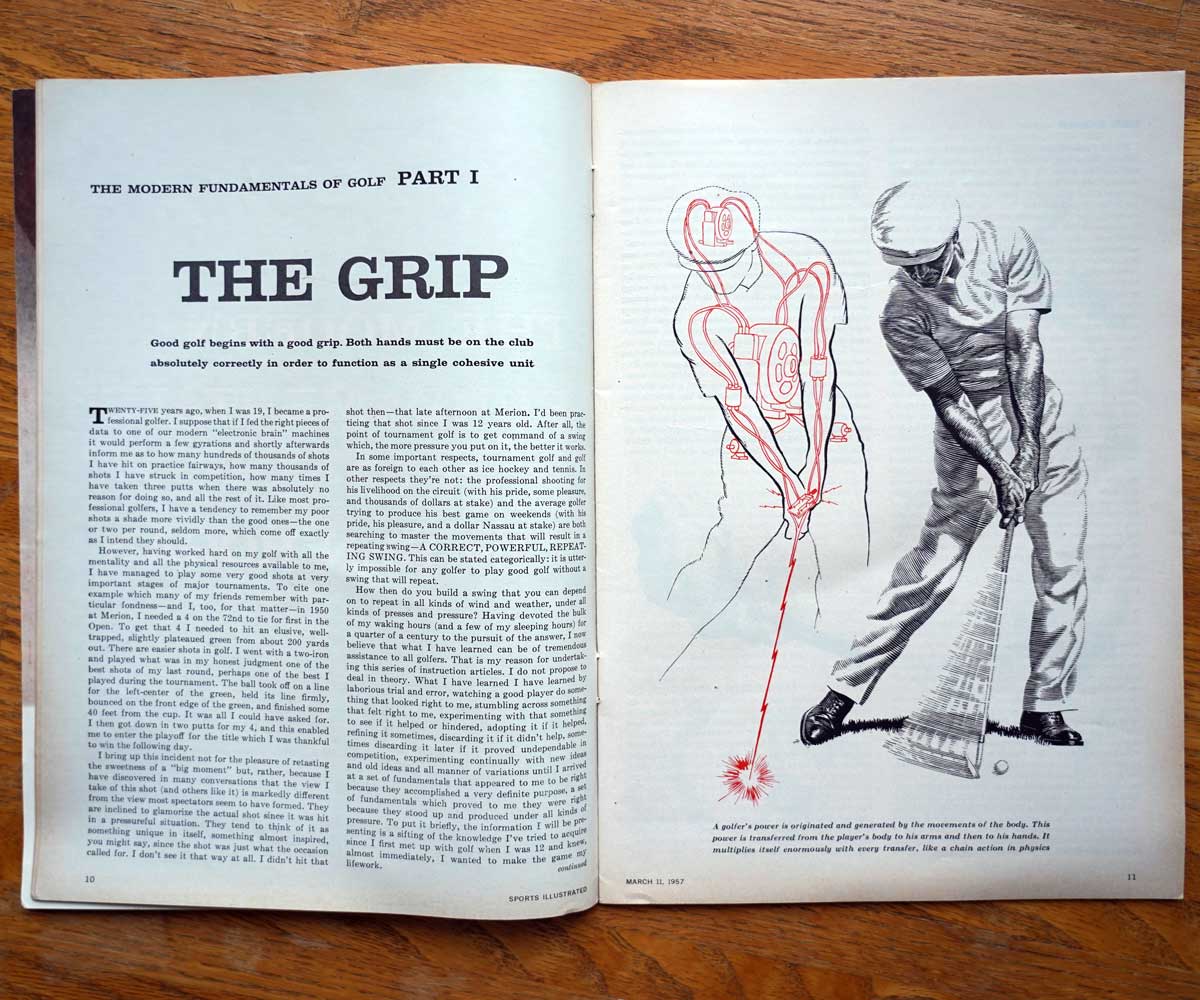Sean Zak

The brand new-edition “5 Classes” has an electrical inexperienced cowl, a nod to the Sports activities Illustrated article from which it was spawned.
Sean Zak
In relation to golf books, publishers imagine in two absolutes. First, golf literature usually sells higher than lit about different sports activities. The countless sport is so relatable that it’s fairly readable, too.
Second, golf books are routinely revealed just a few occasions a yr: April, across the Masters; mid-June, to align with Father’s Day and the peak of the golf season; and throughout the holidays, when the right stocking stuffers are a sleeve of balls and a $19 paperback.
Perusing the highest golf books on Amazon, although, would possibly go away you puzzled. One of the best-selling golf guide at present is identical bestseller from three months in the past. And three years in the past. And, sure, even three many years in the past. It’s “Ben Hogan’s 5 Classes,” first printed in Sports activities Illustrated in 1957.
Not solely does the exhausting copy version constantly rank among the many high 5 golf books — usually at no. 1 — however the Kindle model usually additionally sits inside the highest 25. Final weekend the audio guide checked in at No. 58. Most titles yearn for simply one of its editions to steadily stream inside the highest 100. Hogan’s knowledge — as instructed to legendary golf author Herb Wind and illustrated on scratchboard by Anthony Ravielli — continues to be extensively consumed in each medium. If the Guidelines of Golf are this sport’s 10 Commandments, then this guide is the closest factor it has to a Bible.
A typical query accompanies that concept: Ought to or not it’s?
That relies on who you ask. In spite of everything, many a 12-handicap has drowned within the complicated variations Hogan particulars between supination and pronation. A greater query then is how has the guide endured over time? Seemingly each elite skilled of the twentieth century had an instruction guide, or a number of, of their title. Watson, Nicklaus, Trevino, Palmer, Snead. How and why did Hogan’s separate itself?
John Garrity had a greater view than anybody. Earlier than a prolonged profession on the golf beat at Sports activities Illustrated, Garrity was an affiliate editor at Simon and Schuster within the early Nineteen Seventies, the place as-told-to instruction books had been practically at all times given the inexperienced mild. The books didn’t value a lot and didn’t earn a lot, Garrity says, however additionally they by no means misplaced cash. All of them appeared to promote across the identical variety of copies — 12,000 — irrespective of who graced the duvet. “There’s solely been a pair exceptions to that,” Garrity stated. “Ben Hogan’s ‘5 Lesson’ is one which offered extra.”
Means extra.
Estimates from trade consultants — the manuscript has been licensed to dozens of publishers through the years — peg the variety of copies offered at greater than 1,000,000. And counting. This week, Simon and Schuster revealed a fortieth anniversary version of the guide, leaving the unique textual content untouched however teeing it up with a brand new foreword from Lee Trevino and including 97 new pages of “Historical past, Context, Legacy.” The brand new and improved “5 Classes” is sure in a flashy, electrical inexperienced cowl, a nod to the palate of the unique journal format. SI revealed these 5 classes in installments, in 5 consecutive points, throughout the journal’s infancy in 1957.

Ben Hogan’s 5 Classes
$29
With a brand new introduction by Lee Trevino, that is the primary definitive version of the timeless golf traditional that has offered over 1,000,000 copies—now with never-before-seen images and memorabilia, hand-selected from the Hogan property archive, in addition to practically 100 pages of latest writings that develop on Hogan’s unbelievable life story and extraordinary profession.
Simon and Schuster editor Jofie Ferrari-Adler labored with longtime golf writers Michael Bamberger (a GOLF.com contributor) and Jaime Diaz to convey new life to Hogan, Wind and Ravielli’s work. What they created is sort of a literary museum exhibit. The 67-year-old artifact is the primary occasion, but it surely’s now paired with a lot wealthy context in regards to the males who crafted it. There are sport tales from the ‘50s, columns from the ‘90s, even an interview between Hogan and Ken Venturi from a Nineteen Eighties CBS broadcast. The brand new version is an ode to Hogan, after all, but additionally to one of many sport’s biggest writers in Wind; the guide consists of a few of Wind’s biggest hits, compiled by the following era of writers.
However none of that explains why the guide stays so widespread — or grew to become so widespread to start with — significantly with the arrival of digital golf instruction, a lot of which might be personalised and disseminated by means of the big-screen in your front room and the 6-inch display screen in your pocket.
Like several outdated recipe, “5 Classes’” endurance is fueled by its substances. You had the most effective ball-striker of his era mixed with the most effective wordsmith of his. (Ravielli, the illustrator, was no third wheel.) The compilation took 10 months to finish, however landed in a booming interval for leisure golf. Quickly after SI revealed the teachings, the journal’s editor wrote that Hogan’s musings had been so widespread that readers had been ripping pages out of SI copies on the Yale Membership and golfers within the snowy Northeast couldn’t resist instantly taking to the observe vary.

Sean Zak

Sean Zak
Maybe the most effective trendy comp to Classes’ success is ESPN’s The Final Dance documentary, which revealed a lot of Michael Jordan’s ideas on basketball and his profession for the primary time — and on the excellent time, when the world was sheltering on the top of the Covid-19 pandemic. We had been all at residence and starved for brand new content material, and Jordan, like Hogan, was extra forthcoming than ever earlier than. Hogan, like Jordan, was lengthy believed to own one thing particular, however not often mentioned his skills publicly.
“I feel it truly is the mystique that sells the guide,” Jaime Diaz stated, ”as a result of Hogan was simply such an unimaginable genius and so inward and and reticent to ever speak about something that when he lastly did, it was like, Oh my God, the vault is open lastly.”
The information themselves are dense. Nineteen pages devoted simply to gripping the membership. Twenty-five on setting as much as the ball. The writing is authoritative, bordering on lecturing, with the occasional all-caps clause and loads of italics emphasizing what {the golfing} genius wants you to give attention to. The top objective, in Hogan’s thoughts, was getting bogey golfers to interrupt 80 constantly. However the final ideology of the guide is fairly easy: by no means hit it left.
“It’s an anti-hook guide,” Diaz stated. “I imply, actually weak grip and simply ensuring the membership by no means turns over. It’s a Tour participant’s swing. However even Tour gamers can’t at all times replicate it.”
Therein lies a truism of the sport. No singular set of classes can resolve the golf riddle for the limitless variety of physique varieties and skills we see on a driving vary, even a PGA Tour driving vary. (As Arnold Palmer preached, swing your swing!) That concept, all these years later, is reiterated means up entrance, in Trevino’s foreword. Over the primary 5 pages, Trevino winds again the clock to 1957, when he stumbled upon the journal whereas on a Marines troop ship headed to Japan.
Even Trevino admits he “may not have understood every part Mr. Hogan and Mr. Wind wrote, however their phrases furthered my {golfing} training.” Trevino joined the Marines golf crew overseas and performed greater than ever. After his discharge, he practiced on his personal with two golf balls — one was his rating, the opposite was Hogan’s. A few years later, Trevino visited Hogan’s membership, Shady Oaks, in Dallas; he was transfixed by Hogan’s physique motion, memorizing how Hogan’s hips led his motion. As Trevino writes, “That’s after I began to get good.”
For Trevino, Hogan was each inspiration and creativeness. And isn’t that how golf feels to all of us? If we’re looking for anyone factor on this sport, it’s some form of really feel, cooked up in our creativeness or impressed by one thing. Or somebody. Trevino’s ball flight grew to become a fade, like Hogan’s, however seemed nothing like Hogan’s fade. Trevino had taken “The Fashionable Fundamentals” and made them his personal.















